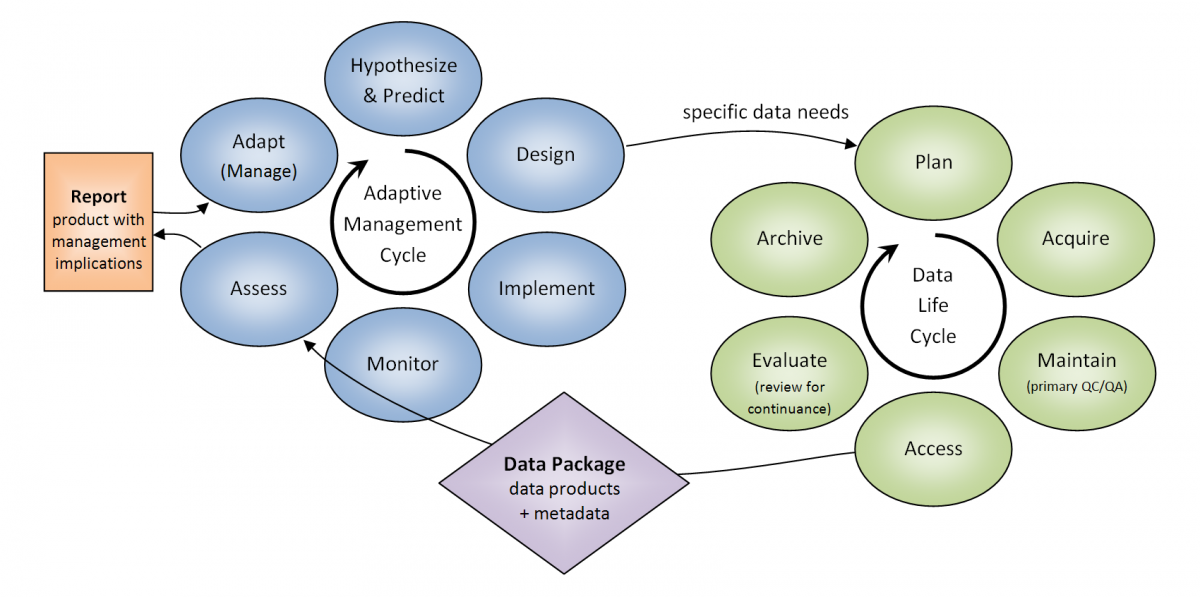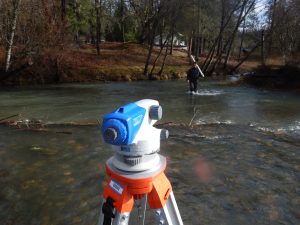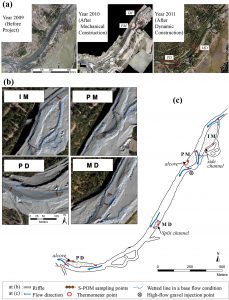The Trinity River Restoration Program was established by the Record of Decision as an adaptive management program, designed to adjust management of the Trinity River – TRRP restoration actions – as scientific knowledge of the river advances.
Why do we use science on the Trinity River when even state-of-the-art science is not perfect? At one point, state-of-the-art knowledge considered the atom to be the smallest unit of matter. Then we came to understand protons, neutrons, and electrons. Then came quarks and other particles. The point is that the river is a complex system that is not fully understood. As scientific knowledge advances, management of our natural resources should be flexible to those advances. This is the underlying principle for “adaptive management”.
Science and monitoring activities to support adaptive management include numerous investigations across scientific disciplines ranging from hydrology and geomorphology to wildlife biology and riparian vegetation ecology. The Integrated Assessment Plan (IAP) provides a cross-discipline perspective and structure for bringing the various investigations together for management recommendations.
ADAPTIVE MANAGEMENT
Key Concepts
Alluvial river systems are complex and dynamic. Our understanding of these systems and our ability to predict future conditions are continually improving. Adaptive Environmental Assessment and Management (or simply Adaptive Management – AM) gives decision makers the ability to refine previous decisions in light of the continual increase in our knowledge and understanding of the river and catchment. Continued... To adequately manage river systems for multiple use and conserve the biotic resources, on going monitoring of flow, sediment, geomorphic, and biological status is essential. With such data and the use of simulation models, river systems can be adaptively managed. Such informed decision-making, utilizing water supply forecasting and predictions of system response, is within the state-of-the art. Establishment of an AM organization will create a focused interdisciplinary effort involving physical and biological scientists. Peer review of all analyses, project design, and monitoring is essential to establish and maintain scientific and public credibility. The AM approach to management relies on teams of scientists, managers, and policy makers jointly identifying and bounding management problems in quantifiable terms. In addition, the “adaptive approach to management recognizes that the information on which we base our decisions is almost always incomplete.” This recognition encourages managers to utilize management actions to increase our knowledge of complex systems; these actions, in turn, result in better future decisions. AM needs to not only monitor changes in the ecosystem, but also develop and test hypotheses about the causes of those changes, in order to promote desired outcomes. The result is informed decisions and increasing certainty within the management process. AM is a formal, systematic, and rigorous process of learning from the outcomes of management actions, accommodating change, and improving management. Traditional approaches to river management are inadequate to preserve biotic community diversity. Scientific knowledge about the interactions of abiotic and biotic factors is limited, and the complexity of species interactions and interrelationships does not lend itself well to traditional single-species management approaches. The concept of ecosystem management is not new; its implementation in regulated rivers is. It is important to stress not just flow recommendations and non-flow channel alterations but also the implementation of a new paradigm of river management built on the two-decade-old concept of Adaptive Environmental Assessment and Management. An AM organization combines assessment and management. Most agency and task force structures do not allow both to go on simultaneously. The basis of adaptive environmental assessment and management is the need to apply lessons learned from past experience, data analysis and fine-tuning project implementation. AM combines experience with operational flexibility to respond to future monitoring and research findings and varying resource and environmental conditions. AM uses conceptual and numerical models and the scientific method to develop and test management choices. Decision makers use the results of the AM process to manage environments characterized by complexity, shifting conditions, and uncertainty about key system component relationships. Effective management strategies must have explicit and measurable outcomes. There are few clear-cut answers to complex population biology, hydraulic, channel structure, and water quality changes. The AM process allows managers to adjust management practices (such as reservoir operations) and integrate information relating to the riverine habitats and the system response as new information becomes available. A well-designed AM organization: The concept of restoring the natural hydrograph pattern discussed by Poff et al. is still debated, especially the role of hydrologic variability in sustaining the ecological integrity of river ecosystems. Stanford et al. also discuss ecological integrity. An adaptive management approach to increase our knowledge and management ability should be accompanied by physical process modeling and an evaluation program to monitor the physical and biological responses. Physical and biological processes will be modeled to facilitate the AM approach to restoring the unique fish fauna by designing a program for rehabilitating the river channels to provide habitats much improved over existing conditions. Such a program, similar to the recommendations by Ligon et al., needs to be supported by a rigorous prediction, monitoring and model validation program. The creation of an interdisciplinary team of scientists to run simulations, design and carry out monitoring programs, and offer recommendations to management is critical to successful implementation of the AM philosophy. “The ultimate products of the TRRP will be two-fold: a more functional river, and the information we gather about it. To provide either of these, TRRP needs data use and management to be clear and efficient.” – TRRP Data Management and Utility Plan TRRP data stewardship enables both solid data management practices and the effective use of data throughout our partnership. Data include both numerical data sets and other information sources, such as documents and photographs. Continued... Data Life Cycle is driven by the Adaptive Management Cycle Data Stewardship operates both at the programmatic level in TRRP, and within individual partner agencies. Resources at the programmatic level in TRRP include: Data Management and Utility Plan: The data plan, completed in 2012, clarifies structure for data stewardship, and procedures by which data will flow among the agencies and staff involved in the TRRP. The plan includes establishing an information repository, to include the Online DataPort. The data plan was developed by the Data Team, an inter-agency work group that was tasked with ensuring efficient use of data across agencies. Integrated Assessment Plan (IAP): The IAP, completed in 2009, provides structure for planning of science and monitoring projects with linkages between hypotheses, assessments, and projects that collect data. (Data Life Cycle step: Plan) Work Planning Process: This is an evolving process for “investigation plan” proposals, review, and budget development. (Data Life Cycle step: Plan) Investigation Plan and Data Collection Database: This provides a tracking system for TRRP investigations while simultaneously capturing details of data collection that will foster collaboration between investigations and maximize data use efficiency. (Data Life Cycle step: Plan, Acquire) Data Inventory: This lists finalized datasets in use by TRRP with links to metadata and, when possible, data downloads. (Data Life Cycle step: Access) RESTORATION PAGES Decision Making Under Adaptive Management
DATA STEWARDSHIP



